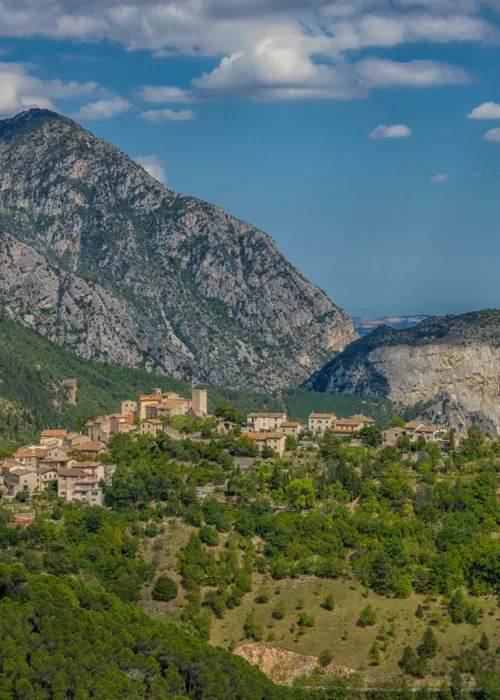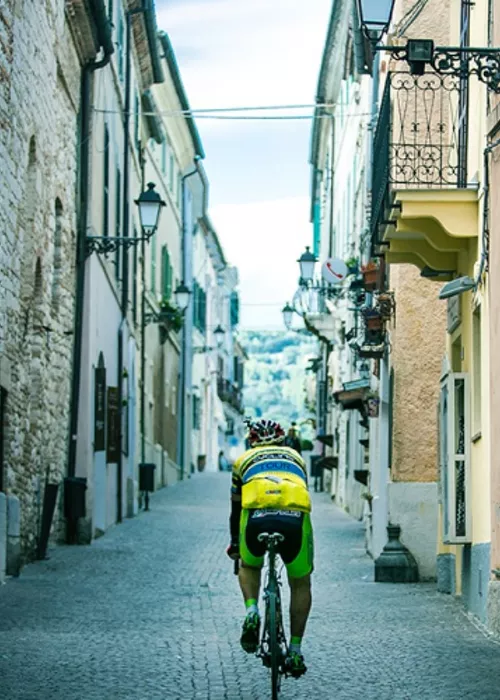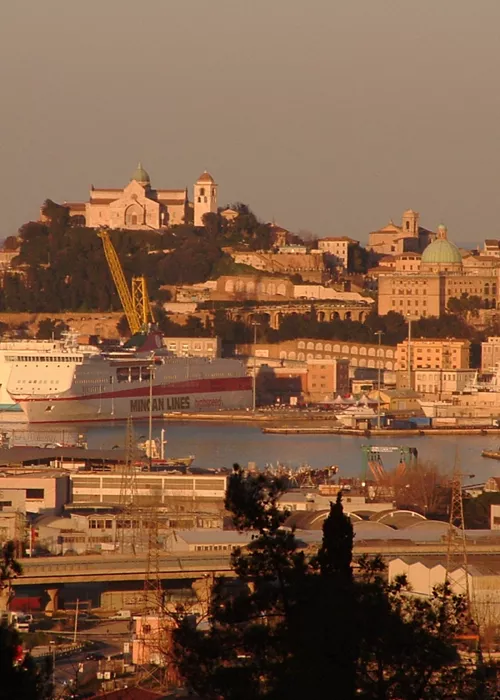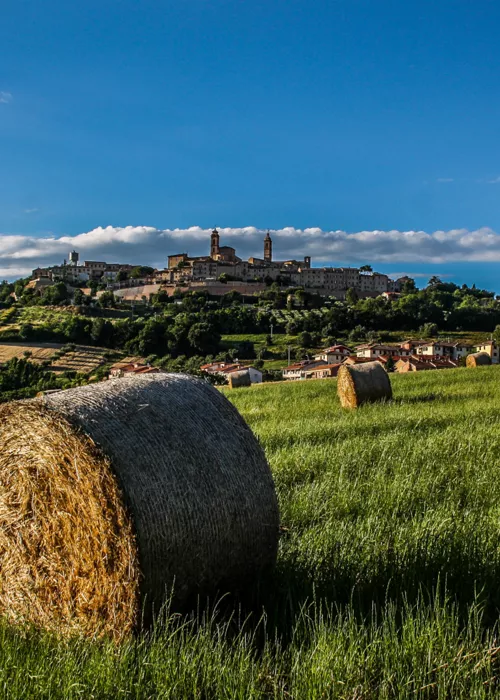Sassocorvaro and its extra virgin olive oil that smells of history

The tour to discover the Marche region of oil starts from Sassocorvaro Auditore, an ancient and suggestive medieval village that rises in the Foglia Valley, in the Province of Pesaro and Urbino, close to Lake Mercatale. The village was built around a bizarre turtle-shaped fortress, the famous Rocca Ubaldinesca, designed by Francesco di Giorgio Martini. Visiting it is like taking a dive into the past, full of battles and secret hideouts. Not everyone knows that during the Second World War this fortress protected from the sight of the Nazis more than ten thousand masterpieces by artists such as Piero della Francesca, Carlo Crivelli, Raphael, Titian, Lorenzo Lotto and Andrea Mantegna.
This charming village, steeped in history and tradition, is now renowned for its production of high quality extra virgin olive oil. The vast olive groves that surround it shape a harmonious and tranquil landscape, perfect for those seeking meaningful experiences in nature and a chance to rediscover the authentic flavors of artisanal olive oil.
The extra virgin olive oil produced here is a true treasure of nature, a gift that contains all the passion and tradition of this land. With a bright golden color, its intense and enveloping aroma transports the senses on a journey through fields of centuries-old olive trees and sunny hills that you can continue at the table, combining this special oil with cured meats and cheeses produced in this area.
Oil and ancient peasant traditions: a journey to discover the DOP Cartoceto di Mombaroccio oil

From Sassocorvaro, the journey of discovery of the oil of the Marche region leads to Mombaroccio, a town where the famous Cartoceto DOP Oil is produced, the only Protected Designation of Origin in the Marche region.
This prized oil is of interest to a specific geographical area of the Province of Pesaro and Urbino, which includes not only Cartoceto, from which the DOP takes its name, but also numerous neighbouring municipalities, and within this limited territory the entire supply chain activity takes place: harvesting, milling, bottling.
Mombaroccio, a charming medieval village in the Marche region, is well known for the Convent of Beato Sante, an ancient Franciscan hermitage dating back to the 13th century and a significant destination for spiritual pilgrimages. The village preserves a strong rural identity, reflected not only in the olive groves scattered across the landscape but also in the evocative Museum of Rural Civilization, located in the underground chambers of the Convent of San Marco. Among its exhibits, the room dedicated to traditional olive oil production stands out, showcasing historical tools and equipment once used for harvesting olives and pressing oil, a valuable testament to the area’s agricultural heritage.
A journey through Ostra, in the footsteps of olive oil

Leaving Mombaroccio behind, the journey continues towards Ostra, a town in the Province of Ancona where the Raggia olive cultivar is widely grown. This variety produces a well-balanced, fruity oil with characteristic almond notes and is also appreciated as a table olive thanks to its particularly sweet flesh.
Set on one of the gently rolling hills that define the Marche landscape, overlooking the Misa Valley, Ostra is surrounded by a striking 1,200-metre-long medieval wall - a lasting witness to centuries of invasions. Once here, make sure to visit the Church of San Francesco, whose interiors feature frescoes by Filippo Bellini and several paintings by Ercole Ramazzani. In November, you can take part in the olive harvest, which for many local families is a moment of celebration and togetherness.
Let the fragrant scent of olives guide you as you visit local farms. In autumn, many of them offer experiences such as hand-picking olives, guided tours of their mills, tastings, and cooking classes focused on using olive oil in the kitchen.
Montecassiano and Mogliano: the olive oil villages of the Marche

Heading further south, the next stop is Montecassiano, a hilltop village enclosed by towering medieval walls, set among the rolling hills of the Macerata area. Enter through one of the town’s three ancient gates and you will find yourself in the splendid Piazza Unità d’Italia, a 12th-century square overlooked by the Palazzo dei Priori. During your visit, don’t miss a walk through Parco del Cardeto: a 1.2-hectare green area located just below the castle walls, featuring a scenic nature trail, a botanical garden, and a picnic area where you can enjoy a relaxing break with fresh bread, local olive oil, and traditional cured meats.
After this scenic pause, continue on to Mogliano, known as the “olive oil village”, lying between the Adriatic Sea and the Sibillini Mountains. This area is home to the celebrated Piantone di Mogliano, a native olive variety also known as “Limoncella” due to the lemon-like shape of its fruit. A visit to one of the local olive mills is not to be missed, along with the many tastings offered by the region’s farms. This lightly fruity oil is ideal for drizzling over delicate dishes, bringing out their flavour without overwhelming it.
Before you leave Mogliano, take the time to visit one of the workshops where artisans create and sell handmade wicker and bamboo items once used for olive harvesting. Mogliano is considered one of the leading centres for this craft, both in Italy and internationally.
In search of Sargano olive oil in the heart of the Marche

When it comes to quality olive oil, a stop in Fermo is a must. This area is home to Sargano olive oil, a typical variety widely found across the province. It has a medium fruitiness and a distinctive almond aftertaste that makes it truly stand out. Once you arrive in the lively city, after tasting the local extra virgin olive oil paired with regional culinary specialties, you can continue your visit with a cultural stop at the Palazzo dei Priori. This historic building, the oldest in the city, houses both the Archaeological Museum and the Civic Art Gallery — two key attractions that showcase the artistic and historical richness of the Marche region.
Inside, you’ll find the remarkable Sala del Mappamondo, home to an extraordinary globe created in 1713. Measuring 185 cm in diameter and 568 cm in circumference, it is an impressive sight.
Let the scent of freshly harvested olives lead you to one of the many local farms offering olive oil tastings throughout the year.
Sargano olive oil from Fermo is a true gift of nature, rich in tradition and craftsmanship, and deeply rooted in this land. Its bright golden colour and full, aromatic scent offer an emotional experience with every taste. Each drop tells a story - of ancient olive trees, of skilled hands, and of knowledge passed down through generations. This is more than just a condiment. It is a unique and authentic journey of the senses.
Appignano del Tronto: in the homeland of the famous Ascolana olive

The final stop on this journey through the olive oils of the Marche is Appignano del Tronto, a small village in the Province of Ascoli Piceno. Perched on a ridge and surrounded by streams, it is a true haven of natural beauty and landscape.
In this area, olives are the heart of one of the Marche’s most iconic dishes: olive all’ascolana, meat-stuffed olives that are then breaded and fried. More than just an appetiser, they are a true masterpiece of true Italian cuisine.
The Ascolana tenera olive has been the star of this area since Roman times. Pliny himself wrote about the moment the Romans conquered the Piceno area and began transporting excellent olives back to Rome. The olives were preserved in barrels using seawater, and during the long journey from San Benedetto del Tronto to the capital - often lasting several months - they mellowed, developing a uniquely delicate flavour. Today, many local farms are working to preserve this genetic heritage by cultivating the Ascolana olive in a natural way, keeping its distinctive qualities intact.












?wid=500&hei=700&fit=vfit,1&fmt=webp)


